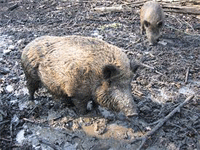 Dozens of pigs in the village of Akhalsofeli in the Zugdidi District have died from African fever, also known as Montgomery’s Disease, in the past five days. Locals are trying to fight against the disease with their own resources. They dig graves near the forest and bury the diseased pigs there. The total damage amount is large and methods of fighting against the virus are minimal. The government’s solution to the problem is to kill all healthy and diseased domestic animals. The population, however, does not appreciate the idea of killing the animals, but recognize that the danger is gradually increasing. As of June 27th, 2007, 2,847 pigs had died in Zugdidi district and 9,461 pigs had died in the whole of the Samegrelo Zemo-Svaneti region.
Dozens of pigs in the village of Akhalsofeli in the Zugdidi District have died from African fever, also known as Montgomery’s Disease, in the past five days. Locals are trying to fight against the disease with their own resources. They dig graves near the forest and bury the diseased pigs there. The total damage amount is large and methods of fighting against the virus are minimal. The government’s solution to the problem is to kill all healthy and diseased domestic animals. The population, however, does not appreciate the idea of killing the animals, but recognize that the danger is gradually increasing. As of June 27th, 2007, 2,847 pigs had died in Zugdidi district and 9,461 pigs had died in the whole of the Samegrelo Zemo-Svaneti region.
Iliko Jojua, a resident of Akhalsofeli village in Zugdidi district, dug a large grave himself near the forest and buried nine pigs there. The peasant is looking for the solution how to provide for his family.
Iliko Jojua: “My nine pigs died over the span of one day. They were motionless for three days and could not even eat…I could not save them. Now I have no pigs for Christmas Day. (It is custom in Georgian villages that people kill pigs before Christmas and eat the meat at festivities on Christmas Day).
Pigs have died in the village of Sakadario, as well. Villagers have sought the help of a veterinarian in vain. They have buried almost fifty pigs.
Marina Kadaria: “I noticed that my pigs were falling down and could not eat anything. On the third day of this behavior, I asked the veterinarian for help. He advised me to buy some medicine at the chemist’s. However, the doctor was not sure of the efficiency of the medicine. I injected all three pigs but it was too late or it would not have worked at all.”
Mimoza Jojua is worried about her living pigs and is not sure that she will be able to save them. “One of my pigs has already died and the other three have fallen ill, though they are still alive. I cannot help them and they neither eat nor move. I do not even know what to do with them, if I should bury or burn them. I have not sought anyone’s help and we have not informed the local government either.”
The local government has already received reports about the problem and sent Zenor Guaia, the chief of the Zugdidi District Department for Product Safety, Veterinary and Plant Protection, to Akhalsofeli to study the situation there. Today, officials found only graves of pigs in the village. Gulaia does not doubt that the reason for the death of the pigs was African virus. He does not, however, want to make final conclusions before he examines the deceased animals.
“The villagers had already buried their pigs when we arrived here; so we could not see dead pigs. We need to examine the diseased animal to conclude whether it was African fever or not. If the population notices that their domestic animals are getting weak they should apply to our department; it will help us to arrive on the place in time.”
According to the Zugdidi District Municipality, the only effective method to fight against the disease is liquidation of the area’s livestock.
Darejan Gabedava, Deputy Governor of the Municipality: “If it is shown that African fever is the problem in Akhalsofeli, we will have to apply to the Ministry of Agriculture to carry out the liquidation of the animals. It is unfortunately the only way to fight against the disease. Currently, we can also consider isolating the healthy animals as a way to prevention the problem. When authorities started to kill the animals, the population became very annoyed. They did not consider it necessary to kill healthy pigs but there is no other way out of this problem.”
This is the second outbreak of African fever in Zugdidi district. The outbreak originated in the village of Narazen, with nearly 3,000 pigs dying in Zugdidi District and 10,000 in Samegrelo Zemo-Svaneti Region overall. The Georgian Government set aside 350,455 lari from the Reserve Fund to liquidate infected livestock and 15, 300 lari was transferred to Zugdidi District directly. The money is to be spent on the liquidation and safe disposal of diseased pigs with the project expect to begin soon.
Nana Fazhava, Zugdidi
News
December 13, 2023
Ethnic minorities outside the peace dialogue
November 6, 2023
‘Peace’ agenda of political parties
Popular
Articles
February 13, 2024



